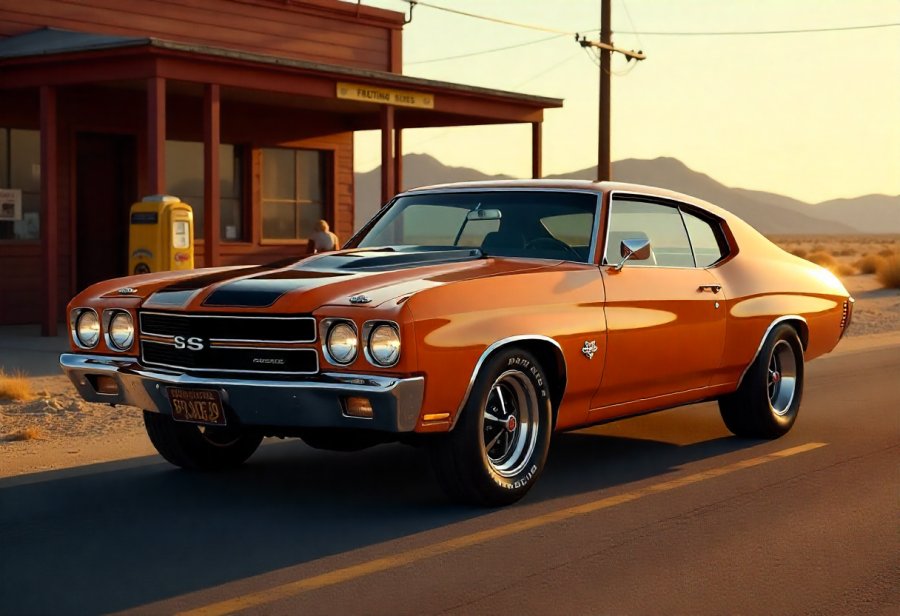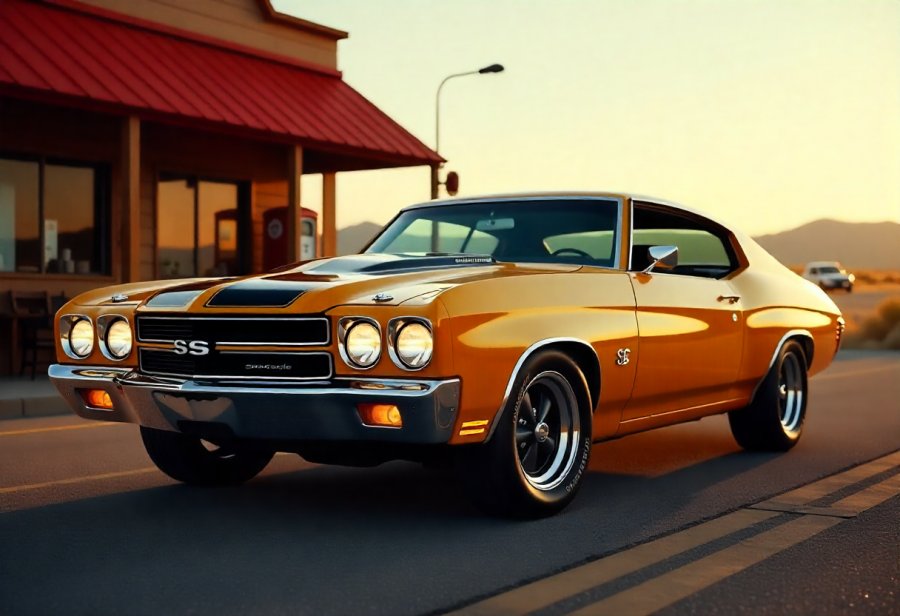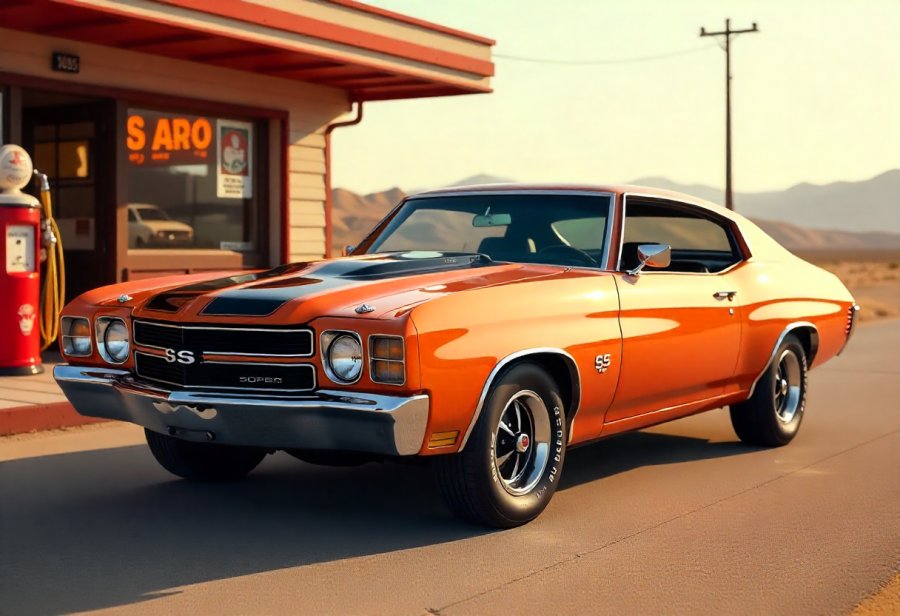Step into the exhilarating world of the 1970s Chevrolet SS, a symbol of American muscle car bravado and raw power. These iconic vehicles, with their aggressive styling and thunderous V8 engines, defined an era of rebellion, speed, and style. From the bold lines of the Chevelle SS 454 to the sleek Camaro SS, each car narrates a story of innovation, competition, and cultural significance. Today, enthusiasts passionately restore and preserve these classics, keeping the spirit of the golden age alive through clubs, shows, and modern upgrades. As automotive technology advances, the future of muscle cars hints at electrified powertrains and continued evolution, blending nostalgia with innovation. Will the primal roar of these machines survive the shift to sustainability, or will a new chapter redefine what horsepower truly means? One thing remains certain: these cars embody freedom and attitude, echoing a legacy that still fuels passion and identity.

Revving Up Nostalgia: The Iconic Muscle Car Era of the 1970s
The muscle car era of the 1970s stands as one of the most thrilling chapters in American automotive history. It was a time when manufacturers pushed the boundaries of design and performance, creating machines that embodied freedom, rebellion, and raw power. These cars weren’t just transportation—they were symbols of attitude, daring drivers to stand out and make a statement. Among them, the Chevrolet SS shines brightly as an icon of that golden age, representing everything that made muscle cars legendary: aggressive styling, thunderous engines, and an unapologetic pursuit of speed.
The Chevrolet SS, especially during this era, captured the imagination with its bold lines and muscular stance. Wide, imposing bodies with cowl-induction hoods and racing stripes communicated power before the engine even roared. Underneath, a massive V8 engine—most famously the Chevelle SS 454—delivered up to 450 horsepower, making it a force to be reckoned with on the street. These cars balanced performance and style, offering comfortable interiors that made daily driving a joy while still leaving a trail of smoke and rubber behind at a moment’s notice.
More than just vehicles, muscle cars like the Chevrolet SS became cultural icons. Their presence in movies, music, and car shows helped cement their legendary status. They symbolized independence and daring, embodying a rebellious spirit that still resonates today. Driving or even just admiring these cars sparks nostalgia and excitement, transporting enthusiasts back to a time when horsepower was king and the open road beckoned with promise.
This era was also marked by a relentless pursuit of innovation. Despite increasing safety and emissions regulations, manufacturers found ways to enhance horsepower and style, pushing the limits of what muscle cars could be. The bold aesthetics—wide bodies, aggressive grilles, and racing-inspired details—made these cars stand out. They weren’t just fast; they were designed to turn heads and ignite passions, setting standards that continue to influence automotive design.
Today, the legacy of the 1970s Chevrolet SS endures in the hearts of collectors, restorers, and fans. These cars symbolize a rebellious, energetic spirit that refuses to fade. Whether restored to their original glory or reimagined with modern touches, they remain a testament to American horsepower’s enduring appeal. The roar of these vintage machines continues to inspire, echoing the excitement and freedom that defined the muscle car era of the 1970s.
From Roots to Roar: The Evolution of the Chevrolet SS During the Golden Age
The roots of the Chevrolet SS trace back to the late 1960s, a period when muscle cars were taking the American roads by storm. Chevrolet aimed to compete at the top of the high-performance segment, and the Chevelle SS 454 quickly emerged as a flagship of raw power and speed. Its aggressive styling combined with a massive 454-cubic-inch V8 engine set a new standard, appealing to enthusiasts eager for straight-line dominance. This early model laid the foundation for what would become an iconic lineup of muscle cars that defined an era.
As the 1970s rolled in, the development of the Chevrolet SS reflected the broader golden age of muscle cars. Automakers engaged in a horsepower war, pushing engines to ever-increasing heights while styling grew more daring and bold. Chevrolet responded with updates that emphasized increased power and striking aesthetic details, like the cowl-induction hood and aggressive body lines. The Chevelle SS 454, with its up to 450 horsepower, became the performance crown jewel, while the Camaro SS offered a sleeker, more aerodynamic option but still packed a punch with its potent V8 engines.
Throughout this era, mounting regulatory pressures and shifting market preferences influenced how these cars evolved. Emissions standards and safety laws meant engineers had to balance raw performance with reliability and legality. Chevrolet worked diligently to refine engines, suspension, and handling, making their muscle cars not just powerful but more manageable and street-ready. Despite these hurdles, models like the Chevelle SS 454 and Camaro SS maintained their reputation as symbols of American horsepower, embodying a culture that celebrated speed, style, and attitude.
The development of these models also marked a shift from muscle cars being purely about straight-line speed to becoming cultural icons. Their bold aesthetics—wide bodies, racing stripes, and aggressive grilles—made them stand out, whether on the street or at car shows. Chevrolet’s focus on blending performance with eye-catching design helped set industry standards, inspiring competitors and enthusiasts alike. Each new iteration pushed the envelope further, with performance enhancements, aesthetic updates, and new features that kept these cars relevant and desirable.
Over time, incremental updates like new color options, interior refinements, and suspension improvements kept these models fresh and competitive. Chevrolet’s commitment to innovation was evident in features like improved handling and driver comfort, transforming muscle cars into more refined yet still exhilarating vehicles. This balance of power and sophistication helped ensure that the legacy of the Chevrolet SS and its muscle car siblings would endure beyond the golden age, blending the raw energy of the past with modern touches that still excite today.
The evolution of the Chevrolet SS during this period reflects a broader story of American automotive ingenuity. Despite regulatory challenges, the brand’s engineers managed to sustain the performance and style that made muscle cars legendary. Their efforts created vehicles that weren’t just fast—they were symbols of rebellion and freedom, capturing the spirit of an era. This development journey highlights how Chevrolet continuously pushed boundaries to meet both enthusiast expectations and industry standards, cementing its place in muscle car history.

Legacy in Motion: How Chevrolet SS Continues to Inspire Car Culture Today
The legacy of the Chevrolet SS and muscle car nostalgia remains a potent force in today’s car culture. Enthusiasts and collectors continue to celebrate these vintage models through restorations, shows, and online communities, keeping the spirit of the golden age alive. Restoring these cars isn’t just about rebuilding a vehicle; it’s about reconnecting with a storied history of American horsepower and performance. Many seek original parts or craft detailed replicas, striving to preserve the authentic look and feel of these icons while sometimes adding modern upgrades for safety and drivability.
These muscle cars symbolize freedom and rebellion, themes that still resonate deeply. Movies, music, and media frequently feature these vehicles, reinforcing their iconic status and inspiring new generations of fans. Their roaring engines serve as a soundtrack of independence and daring, echoing the bold attitude of an era that continues to influence pop culture. For many, owning or simply admiring a vintage muscle car is a visceral experience—an act of rebellion, craftsmanship, and nostalgia rolled into one.
Restoration and preservation efforts have grown increasingly sophisticated. Owners source authentic parts, employ authentic techniques, and sometimes create meticulous recreations. This dedication ensures that the original design and spirit of these cars are maintained, even as they are driven and enjoyed today. Car shows and online forums foster a community rooted in shared passion and craftsmanship, where stories are exchanged and expertise is passed down. This sense of belonging keeps muscle car culture vibrant and relevant.
The market value of models like the Chevelle SS 454 and Camaro SS continues to rise, reflecting their enduring appeal and investment potential. As more collectors recognize their worth, efforts to maintain authenticity have intensified. Restorers and enthusiasts alike focus on balancing originality with performance upgrades, ensuring these vehicles remain both beautiful and functional. Their growing popularity underscores how deeply intertwined muscle car culture is with American identity, celebrating individuality, power, and style.
Modern reinterpretations of muscle car design further cement their relevance. Automakers draw inspiration from the bold, muscular lines of the 1970s Chevrolet SS, integrating these elements into contemporary models. Aftermarket parts allow owners to personalize their rides, creating a dialogue between past and present. This ongoing evolution keeps the spirit of muscle cars alive, appealing to a new generation while honoring the classic lineage.
For many enthusiasts, muscle cars are more than just vehicles—they are a lifestyle. Car clubs, rallies, and cruises foster camaraderie and shared passions. Driving a restored Chevelle or Camaro reconnects owners with the rebellious attitude of the era and the thrill of raw power. These gatherings strengthen community bonds and celebrate craftsmanship, authenticity, and the enduring appeal of muscle cars. The passion for these icons continues to fuel a vibrant, living culture that honors the past while shaping the future.
Reviving the Past: How Muscle Car Nostalgia Shapes Modern Restoration and Lifestyle
The love for muscle cars like the 1970s Chevrolet SS goes far beyond admiration; it actively shapes how enthusiasts and professionals approach automotive work today. Restoration projects have become a passionate pursuit, with owners dedicating time and resources to bring these iconic vehicles back to their original glory. Many source authentic parts or craft detailed replicas, aiming to preserve the vintage look while sometimes adding modern upgrades for safety and driving comfort. Car shows and online communities serve as hubs for sharing tips, swapping parts, and celebrating achievements, strengthening a sense of camaraderie rooted in shared passion.
This culture of restoration influences automotive shops as well. Specialized mechanics now focus on maintaining the authenticity of vintage muscle cars, employing techniques that honor their original design. They often incorporate modern safety features—such as upgraded brakes or suspension systems—without compromising the vintage aesthetics. This blending of old-school craftsmanship with contemporary technology allows owners to enjoy their cars regularly, transforming restoration from a hobby into a personal expression of creativity and pride.
The aesthetic and attitude of muscle cars continue to inspire modern automotive design. Many manufacturers draw from the bold, muscular lines of the 1970s Chevrolet SS, incorporating these elements into new models that appeal to both nostalgic collectors and new fans. Aftermarket parts, like period-correct logos, wheels, and body panels, enable owners to customize their vehicles and maintain the dialogue between vintage style and modern innovation. This ongoing exchange keeps muscle car culture vibrant, making classic design language relevant in today’s market.
For many enthusiasts, muscle cars are more than just showpieces—they’re part of a lifestyle. Car clubs and rallies regularly organize cruises, meetups, and events that celebrate the raw power and bold styling of these vehicles. Driving a restored Chevelle or Camaro becomes a visceral experience, connecting owners directly with the rebellious spirit of the era. These gatherings foster community, emphasizing craftsmanship, authenticity, and shared excitement for the open road, keeping the culture alive and thriving.
Personal garages often become dedicated spaces filled with memorabilia, tools, and parts that reflect a deep passion for muscle cars. Working on these vehicles offers a therapeutic escape, cultivating patience and attention to detail. For many owners, maintaining and customizing their cars is a form of self-expression and a way to honor the legacy of American horsepower. This lifestyle nurtures a community that celebrates craftsmanship and innovation, ensuring that the spirit of the muscle car era continues to inspire new generations of enthusiasts.

Gazing Forward: The Future of Muscle Cars and the Evolution of Performance
The future of muscle cars, both vintage icons and modern reinterpretations, is shaping up to be as exciting as it is unpredictable. Advances in technology are opening new doors, allowing automakers to blend nostalgic design with cutting-edge performance. Electric drivetrains, for example, are starting to make their mark in muscle-inspired models, offering instant torque and blistering acceleration without the exhaust noise or emissions of traditional engines. This shift aligns with global sustainability efforts while redefining what raw power can mean in the modern era.
At the same time, the market for classic models like the Chevrolet SS remains strong. Restoration and preservation efforts have become more sophisticated, with enthusiasts sourcing authentic parts or crafting meticulous recreations. Many owners are now incorporating modern upgrades—such as improved suspensions, enhanced safety features, and performance tweaks—so these cars can be enjoyed regularly without sacrificing their vintage soul. This balancing act keeps the legacy of these muscle cars alive, ensuring they remain relevant and thrilling to drive.
Regulatory pressures and evolving consumer preferences pose challenges, yet they also inspire innovation. Some worry that the pure, unfiltered experience of a traditional muscle car might fade if strict emissions standards limit internal combustion engines. However, many see this as an opportunity for reinvention. Electric muscle cars, with their instant torque and modern flair, promise a new kind of exhilarating performance that pays homage to the primal spirit of horsepower. The key is preserving the bold styling and attitude that define muscle cars, even as their powertrain technology evolves.
Looking ahead, a blend of old and new is likely to dominate the scene. Automakers are experimenting with sleek, modern designs that incorporate the muscular lines and aggressive details of classic models, while embedding advanced technology beneath the surface. Meanwhile, the muscle car community continues to champion authenticity, with restorers and collectors working tirelessly to maintain original features or recreate faithful replicas. This ongoing dialogue between tradition and innovation ensures that muscle cars will continue to inspire and excite for generations to come.
The cultural impact of muscle cars will persist as well. Their rebellious attitude and sense of freedom remain powerful symbols, resonating with new audiences through media, car shows, and community events. Electric or not, the roar of a muscle car’s engine isn’t just about speed; it’s about identity, independence, and pushing boundaries. As technology advances, so does the capacity for these vehicles to embody that spirit in fresh and unexpected ways, keeping the legacy alive.
In the end, muscle cars are more than just machines—they’re a living part of American culture that evolves alongside society. Whether through nostalgic restorations or innovative electric models, their roar will continue to echo in streets, garages, and hearts alike. The future holds the promise of maintaining their timeless appeal while embracing progress, ensuring that the primal allure of horsepower remains a vital part of automotive culture for years to come.